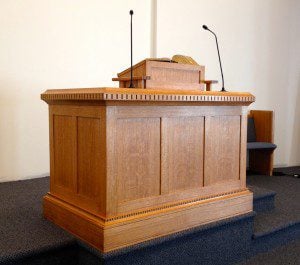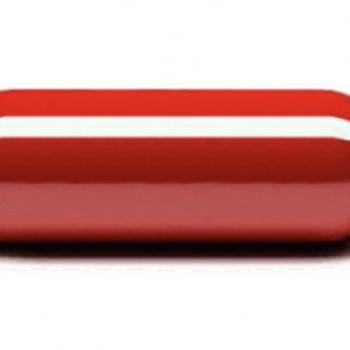
I designed it and it was built by a furniture maker in my church. It is made from hand selected quarter-sawn red oak from the Berkshire Mountains.
Animals, I assume, are literalists.
Metaphors, analogies: animals just don’t get them. I tried a few on my dog. No success. Culture is just lost on him.
I’ve observed that philistines are literalists too. (I’ll let you make the connection.)
There is something philistine to Protestantism, at least in its lowest expressions. I suppose that has something to do with being against things, i.e. “protesting”. The finer arts tend to be for things; they’re allusive. There’s a “this is that”ness about them. And since many Protestants are adamant that “is” doest really mean “is” they tend to miss what “is” is for.
I’ve been thinking about this because I’m designing the liturgical furniture for my church. Since I’m a Presbyterian it’s not a long list: pulpit, table, and font.
I’m fortunate to have a master furniture maker in my congregation. I draw up a concept, he works with it, makes a model, brings it back for review, and so forth. The furnishings themselves are then constructed from quarter-sawn red oak from the Berkshires. Naturally, since we’re Presbyterians, we started with the pulpit.
I asked some folks recently for their thoughts on pulpits. I’m happy to say they all agreed that pulpits are important. They said that a pulpit should be big, well-made, and even majestic. But when asked why, they couldn’t quite say. For them it basically it came down to, “Preaching is important and a pulpit should say that.”
It’s a start.
As already noted, I’m a Presbyterian, so I like to start with the Bible when I can. Beginning there, the go to for liturgical furnishings is the tabernacle in the wilderness. The instructions for its making were detailed, their arrangement precise. And we see from the book of Hebrews that this wasn’t just fussy or capricious, the furnishings were allusive. They mirrored the heavenly court.

It is a Gnostic abomination. If you insist on having one of these–here’s where I got the photo: http://www.displays2go.com/P-24090/Acrylic-Pulpit-has-1-Shelf?utm_source=google.pla&utm_medium=cpc&utm_campaign=GooglePLA&gclid=Cj0KEQiA7rmzBRDezri2r6bz1qYBEiQAg-YEtu7cGUa7-hgE9IUbj2z02xj3x-C65_w4nYW2OuWA1qgaAj7L8P8HAQ
Our tendency to separate religion and politics, and to moralize and privatize worship, keeps us from seeing this connection. The altar (which was outside the tent, by the way) was for winning the favor of a king, the laver made supplicants presentable, the table for the bread was for sharing a meal with the king (12 loaves, recall, for the 12 tribes, the people of God), but the most important item in the tabernacle was the Ark of the Covenant.
What was it? Sure, it was a box. It held things. It contained the tablets of stone, the 10 Commandments, Aaron’s staff, and a jar of manna. There were the cherubim on top, bowing toward the center (that should have put to rest the notion that statuary necessitates idolatry, but it didn’t), then there were the poles for carrying it around.
While all those things are significant (they signify things), they’re not the most important thing. The most important thing is the Spirit of God sat on the Mercy Seat between the cherubim on the top of the box.
The Ark was a throne. You can also see that it was a litter, one used to carry a king. (The tabernacle is a mobile court, but that’s okay since it mirrored the eternal and fixed court above.) And the contents of the Ark alluded to the king’s gifts to his people: law, leadership, and provision.
With a little imagination we can see that the traditional arrangement of Protestant furnishings mirror this nicely. Laver for font, table before the Ark for communion table, and Ark for pulpit. Because, yes, the pulpit is a throne. (If I weren’t a Presbyterian, I’d say we got lucky.)
“The Ark was a throne. You can also see that it was a litter, one used to carry a king.”
The pulpit is not the throne of a preacher, and it is certainly not a lectern (I’m sick of hearing that one). It is the throne of the Word. And the Living Word is the Lord Jesus Christ. The Bible points to him. As you can see with the one I designed, the Bible resting on it is enormous. It fills the seat upon which it rests. It can be seen from the furthest reaches of the sanctuary. Because it is Christ, the Living Word who washes and feeds us. the preacher simply proclaims him from every page of scripture. As the saying goes, “It’s not about me.”
Because the Word became flesh we have a reason to believe that matter can speak. Another good reason is the stuff we make furniture out of was made by the Word. Quarter-sawn red oak says something. It’s weighty (my pulpit weighs about four hundred pounds), it’s beautiful too. People can see a connection to the weight of God’s glory, even though they can’t quite put it into words.
One last parting note. If you look carefully you can see that my pulpit is intended to resemble a throne on a box.












